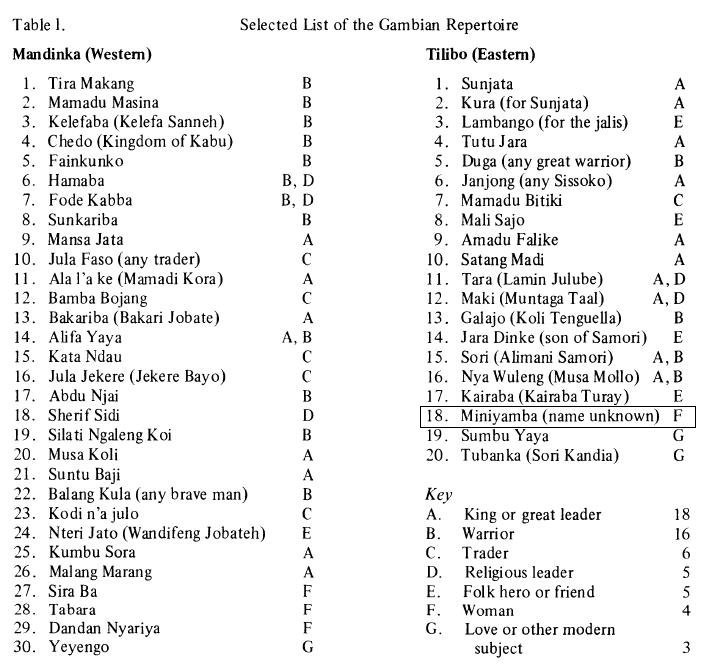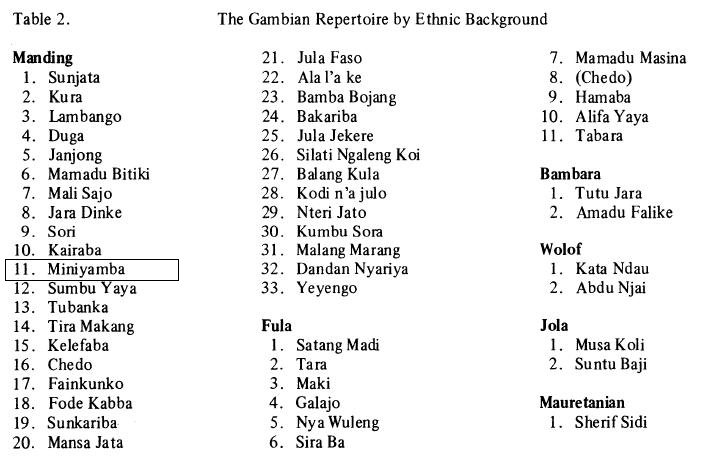miniyamba
Ministère de l’information du Mali. 1971. Première anthologie de la musique malienne: 6. Fanta Damba: La tradition épique. Barenreiter Musicaphon, BM 30L 2506.
(Miniyamba)
This song calls to mind an old legend, namely that of Ghana where people used to sacrifice the most beautiful girl of the Empire to a boa-constrictor for the happiness of all.
Knight, Roderic. 1982a. "Manding/Fula Relations as Reflected in the Manding Song Repertoire." African Music 6 (2): 37–47.
(Miniyamba)
p. 39
Table One . . . includes the best known, most often heard, or otherwise significant songs in the [Gambian] repertoire. In each column the top few songs are the oldest, and the bottom few are the youngest. The majority in each case fall somewhere in between (often in the nineteenth century), but no chronological ordering beyond this is intended, since it is often not possible to date a song exactly. Most of the songs bear the name of their owner as the title. Where they do not, his name is shown in parentheses next to the title. The letter code at the right represents the person's "claim to fame" or calling in life, as shown in the bottom of the list.

p. 40
Table Two shows the same fifty songs again, grouped this time by the ethnic background of the people commemorated.

Jessup, Lynne. 1983. The Mandinka Balafon: An Introduction with Notation for Teaching. La Mesa, Calif.: Xylo.
(Miniyang Ba)
pp. 146–59 (Appendix 2: Balafon Repertoire)
| Title | Miniyang Ba |
| Translation: | Great python |
| Dedication: | a beautiful woman |
| Notes: | often spelled "Miniyamba", animal imagery |
| Calling in Life: | Popular Woman |
| Original Instrument: | Kontingo |
| Region of Origin: | Tilibo |
| Date of Origin: | L (after WWII) |
| Sources: | 1 (Jessup & Sanyang) |
Knight, Roderic. 1984. "The Style of Mandinka Music: A Study in Extracting Theory from Practice." In Selected Reports in Ethnomusicology, vol. 5, Studies in African Music, ed. J. H. Kwabena Nketia and Jacqueline Cogdell Djedje, 3–66. Los Angeles: Program in Ethnomusicology, Department of Music, University of California.
(Miniyamba)
p. 8
The python appears as the title of the song "Miniyamba" (Great Python), with the intention of comparing the beauty of a particular woman to the lithe movement and beautiful markings of the python, although this is not explicitly stated in the song.
p. 16
The secondary Hardino mode places the tonal center on pitch six. "Duga" (the Vulture's tune) and "Miniyamba" (Great Python) use this secondary mode. Here is the donkilo line for the latter:
Example 7. "Miniyamba" (Hardino, secondary mode). This may be heard with kontingo accompaniment, on BM30L 2506, A-4.

p. 19
Melodically we may discern three types of kumbengo, based on their relationship to the donkilo.
Type I: Parallel. . . . In this type, the kora player duplicates the voice part in octaves, plus an occasional fifth. Since technically any donkilo line may be accompanied in this way, some jalolu maintain that this is not a kumbengo at all, but merely a form of birimintingo, or instrumental variation. Still, some songs are traditionally accompanied in this way. "Miniyamba" and "Mali Sajo" (Exc. 7 and 8) are two of them.
Kaba, Mamadi. 1995. Anthologie de chants mandingues (Côte d'Ivoire, Guinée, Mali). Paris: Harmattan.
(Maniamba [Le Gros Boa1])
pp. 19-20
REFRAIN
Maniamba le serpent
Se trouve dans le puits
Le gros serpent boa Maniamba !
Maniamba le puissant Serpent
Se trouve dans le puits
Le puissant Serpent boa Maniamba !
I
Maniamba, si tu t'interposes
Entre deux amoureux
Oh, gros serpent boa Maniamba !
Alors Maniamba
Cet amour mourra
Oh puissant Serpent boa Maniamba !
II
Maniamba, si tu t'interposes
Entre deux mariés
Oh, gros serpent boa Maniamba !
Alors Maniamba
Ce mariage mourra
Oh puissant Serpent boa Maniamba !
1 C'est un chant de sacrifice humain en l'honneur du serpent boa adoré jadis tant au Ghana que dans le Manding animiste. Ce serpent boa auquel on sacrifiait des jeunes filles pour l'obtention de la victoire dans une prochaine guerre, ou pour éviter une calamité, une sécheresse ou la famine. Et si une fille est choisie comme sacrifice, ses fiançailles, son mariage ou ses relations d'amour prennent fin automatiquement pour laisser place à l'impératif du sacrifice. Car les besoins du serpent boa passent avant tout et priment sur toute considération d'amour ou de mariage. Ce morceau a déjà été chanté en malinké par Kadé Diawara, cantatrice au sein del'Ensemble Instrumental et Choral de Guinée. C'est unc hant rituel, aussi lent que le serpent qui rampe. Il a déjà été en registré sur disque.
Diabate, Toumani, and Sidiki Diabate. 2014. Toumani & Sidiki. World Circuit, WCD087.
(Miniyamba)
One of the best known pieces in the Mandé griot repertoire, the legend of Miniyamba goes back to the time of the Wagadu (Ghana) Empire (c 830AD to 1230AD). The story goes that the power of the Empire depended on an annual sacrifice of a young virgin girl to a giant python (snake god), and when the people finally ended the practice, the Empire fell. The song was probably created many years after the fall of the Empire and is a metaphor for the loss of a loved one. The song is played in the 'Silaba' or 'Tomoraba' tuning, which is the old 'original' kora tuning, still widely used in The Gambia.